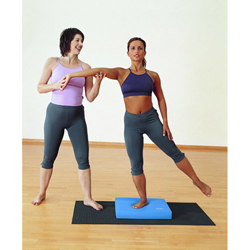The Golden Shoulder
Whether it’s baseball, football, or other sports that involve a throwing motion, athletes playing at any level know the importance of shoulder health and the risk of injury. In recent years, a strong push has been made in baseball to keep a close eye on the pitch count of players; a big step in the right direction. However, issues from repetitive arm movements can still occur for athletes, especially if proper precautions are not taken.
One of the more common shoulder conditions we hear about is the rotator cuff tear, which occurs when injuries to the muscles or tendons cause tissue damage in this area. The American Physical Therapy Association (APTA) has some good information on the anatomy and symptoms of a rotator cuff tear for those who want to learn more. Additional arm injuries include those to the elbow area, such as a tear in the Ulnar Collateral Ligament (UCL) that can result in the need for Tommy John surgery.
Warmup & Injury Prevention
While there are no guarantees when it comes to preventing injuries, there are a variety of healthy habits that we can practice to help reduce our risks. Proper warmup is certainly essential before playing any type of sport or starting an exercise workout. According to the Mayo Clinic, it can not only help reduce injury risk, but also improve athletic performance.
The warmup helps increase blood flow, raise body temperature, and generally prepare your body for the upcoming activity. The Mayo Clinic suggests that an effective warmup can involve doing the same type of activity you’re about to engage in, simply at a slower pace and reduced intensity. For throwing motion athletes, this might mean functional exercises that mimic the arm’s movement.
- Arm Circles. Arm circles are one simple way to increase blood flow and warm up the rotator cuff area. They can be done easily, both arms at once, by just creating small circular patterns. Perform the circles for 20-30 seconds, then reverse direction and perform for another 20-30 seconds.
- Arm Swings. Another simple method to ready the shoulder for activity is a basic pendulum movement. Start by holding on to a solid object such as a pole with one hand. Then, swing the other arm slowly out in front of the body, then behind the body, going back and forth. Try to gradually progress the range of motion.
Perhaps one of the best ways to warm and loosen up the shoulder is internal and external rotation. These movements are excellent for increasing flexibility and range of motion, and can also be key for aiding in injury prevention. Although these exercises can easily be done with resistance bands or resistance tubes, using a pulley system can provide constant, reproducible resistance and a smoother, more functional movement.
The TheraPulley® is a basic but versatile pulley system that can be used at home, while traveling, and on the field warming up before play. Unlike more elaborate systems, it packs up into a bag and can easily be taken with you anywhere you go; a portable “gym in a bag.”
The pulley has two anchors; one is stationary and attaches on top of the door, while the adjustable anchor attaches into the hinged side of the door. This allows for movement in different positions with resistance ranges from 1-20 pounds. Watch the video below to see how it works.
TheraPulley is an excellent functional mobility tool helping to improve joint range of motion, mobilize the joints, and increase blood flow to the muscles. The following shoulder internal and external rotation moves are just two of many exercises that can be performed with the TheraPulley.
1. External Rotation - Elbow at Side
- Mount the bracket on top of the door.
- Insert the plastic lock into the hinge side of the door at the level of your elbow and close the door shut.
- Place the desired weight in the bag. You can use cuff weights and/or household items. The external rotators are sensitive and can get strained if you use heavy weights. Start with light weights (one pound) and increase to your tolerance or as directed by your therapist or doctor.
- Standing sideways with the targeted shoulder away from the door, grab the pulley handle at waist height and move away from your body. Keep your elbow bent at 90 degrees (forearm parallel to the floor).
2. External Rotation - Overhead
- Mount the bracket on top of the door.
- Insert the plastic lock into the hinge side of the door at the level of your shoulder and shut the door.
- Place desired weight in the bag. You can use cuff weights and/or household items. The external rotators are sensitive and can get strained if you use heavy weights. Start with light weights (one pound) and increase to your tolerance or as directed by your therapist or doctor.
- Standing facing the door, lift your arm and keep the elbow level with the shoulder. Keep your shoulder elevated and your elbow bent at 90 degrees. Grab the pulley handle and rotate the fist from horizontal level toward the ceiling (vertical position).
3. Internal Rotation - Elbow at Side
- Mount the bracket on top of the door.
- Insert the plastic lock into the hinge side of the door at the level of your elbow and shut the door.
- Place desired weight in the bag. You can use cuff weights and/or household items. Start with light weights (one to two pounds) and increase to your tolerance or as directed by your therapist or doctor.
- Standing sideways with the targeted shoulder close to the door, grab the pulley handle at waist height and move it to your stomach. Keep your elbow bent at 90 degrees (forearm parallel to the floor).
4. Internal Rotation - Overhead 90/90
- Mount the bracket on top of the door.
- Insert the plastic lock into the hinge side of the door at the level of your shoulder and shut the door.
- Place desired weight in the bag. You can use cuff weights and/or household items. Start with light weights (one to two pounds) and increase to your tolerance or as directed by your therapist or doctor.
- Standing facing away from the door, lift your arm and keep the elbow level with the shoulder. Keep your shoulder elevated and your elbow bent at 90 degrees. Grab the pulley handle and rotate the fist from vertical position to a horizontal level.
The TheraPulley is adaptable for anyone from professional athletes to rehabilitation patients. It has received support from throwing athletes for its role in promoting shoulder health, including high praise from MLB players such as Seattle Mariners hall of fame pitcher Jamie Moyer. As the oldest pitcher to ever start and win a game in the major leagues at the age of 49, Moyer credits much of his extended career and arm health to the TheraPulley.
Prevention is Protection
Preventive exercise can be extremely beneficial when it comes to shoulder health, regardless of your sport, activity, or level of intensity. Not only does a committed warmup aid in athletic performance (increased range of motion, flexibility, and strength), it can help reduce injury risk and ensure the longevity of the shoulder, one of the most mobile yet least stable joint regions in the body.







